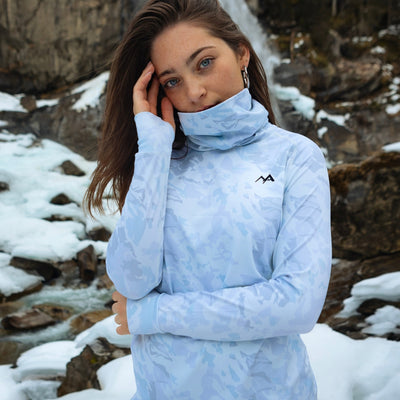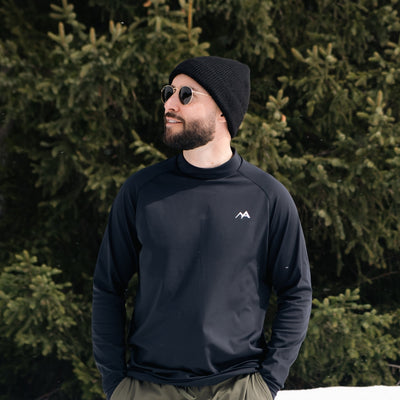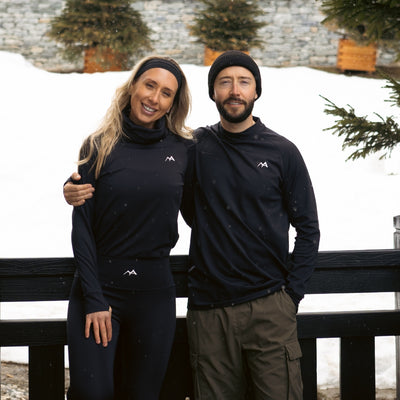Winter hiking is an adventure like no other, but it does require a bit of planning to stay warm, dry, and comfortable. With the right gear and a smart packing list, you’ll be ready to make the most of those snowy trails and crisp mountain views. Here’s a simple guide to help you pack for your winter hike, plus a few helpful tips from our collection to make your experience that much better.
Download our handy Winter Hiking Essentials Checklist to make your experience even easier.

1. Start with a Quality Base Layer: The Foundation for Warmth
Base layers are the unsung heroes of winter hikes. They’re there to keep you warm, dry, and comfortable as you move. Our winter base layers are designed with a soft, second-skin feel that glides against your skin as well as providing optimal thermal regulation - so you’ll stay warm without overheating as you move.
Base Layer Key features: Designed with ultra-lightweight, breathable fabric that wicks away moisture, our base layers keep you comfortable and dry as you heat up on the trail. The seamless design allows you to move freely, whether you’re climbing, reaching, or simply stretching at the summit. Plus, the face and neck warmer add an extra layer of protection against cold winds.

2. Choose Durable, Comfortable Hiking Leggings or Pants
Your legs do the heavy lifting on any hike, so the right hiking leggings or pants are crucial. Our hiking leggings are designed with a high waistband and a soft, flexible fabric for all-day comfort. They’re crafted from breathable, sweat-wicking material, which means they won’t weigh you down as you get active.
Hiking Legging Key features: Our hiking leggings have dual pockets for storage, a seamless front for added comfort, and a high waistband that supports without restricting. Plus, they’re made from recycled materials, so you can feel good about your choice for both comfort and sustainability.

3. Mid-Layers and Outerwear: Ready for Temperature Changes
Weather conditions on winter hikes can change quickly. Dressing in layers you can add or remove easily is key. Bring a warm mid-layer, like a fleece or insulated jacket, and a waterproof outer layer to keep out the elements. This flexibility keeps you prepared for sudden wind, snow, or temperature drops.
Tip: Look for jackets with adjustable hoods and cuffs to help retain warmth on windy days.

4. Warm Accessories for Added Comfort
When temperatures drop, it’s often your hands, face, and head that feel it first. Bringing a hat, gloves, and a scarf or neck warmer can make a big difference. Our base layers come with a built-in face and neck warmer for extra protection, while thumbholes help secure sleeves and add a layer of warmth to your hands.
Tip: A good pair of gloves, preferably ones with touchscreen compatibility, ensures you can check your phone or take pictures without having to take them off.

5. Footwear and Traction: For a Secure Step on Snowy Trails
Winter hikes demand sturdy, insulated hiking boots with good grip to keep you steady on snow and ice. Adding microspikes or crampons to your boots gives extra traction on icy or packed snow trails. Gaiters can also help keep snow, mud, and cold out of your boots, making each step more comfortable.
Tip: Make sure your boots are waterproof and well-fitted to prevent blisters and keep your feet warm.

6. Safety Gear: Be Prepared for the Unexpected
Winter hikes require a little extra safety planning. Keep a navigation tool (like a GPS device, trail map, or compass) with you, since phones can sometimes fail in cold conditions. Carrying an emergency kit with a thermal blanket, a whistle, and first-aid essentials is a good safety measure. A headlamp or flashlight is crucial, as winter days are short, and hiking in low light is always safer with a light source.
Tip: Always let someone know your hiking route and expected return time before heading out.

7. Hydration and Nutrition: Stay Fuelled and Warm
Keeping hydrated and energised is essential, even in the cold. Bring an insulated water bottle or thermos to prevent liquids from freezing and keep them warm. High-energy snacks that won’t freeze, like nuts, protein bars, and dried fruit, are great for refuelling on the trail.
Tip: A thermos with a warm drink can be an excellent way to stay warm and hydrated throughout your hike.
Ready for the Winter Trails
Packing for winter hikes is all about finding the right balance between warmth, comfort, and flexibility. The right base layers and hiking leggings can help make your hike more enjoyable, giving you the warmth and comfort to take on the winter terrain. With some smart choices and a few thoughtful extras, you’ll be set for an unforgettable winter hiking experience.
Download our Winter Hiking Essentials Checklist to keep your winter hikes as easy, cozy, and enjoyable as possible.
Happy trails, and here’s to staying warm and comfortable out there!
















